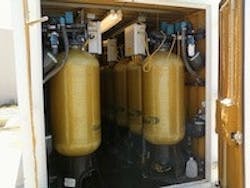Arizona System Successfully Treats Arsenic
When the U.S. Environmental Protection Agency’s (EPA) new arsenic rule took effect in 2006, a small Arizona water system installed an ion exchange treatment system to bring it into compliance, but it soon learned that its highly complex remedy presented a number of costly pitfalls.
After several challenging years, including many sleepless nights for employees responding to an automated alert system, the utility found a long-lasting, cost-saving solution with LayneRT, a patented rapid-adsorptive media from Layne Christensen Co.
Meeting Standards
Operating for more than 20 years with several hundred customers, the utility uses a water supply with a naturally occurring concentration of arsenic of approximately 15 ppb; the new EPA rule reduced allowable arsenic levels from a maximum contaminant level (MCL) of 50 ppb to 10 ppb.
To meet the new standard, the utility purchased a used ion exchange arsenic filtration system from a nearby city. The 240-gal per minute (gpm) system, which cost approximately $1 million to purchase and install, was operational by the end of 2007.
However, the very capable water-system operators soon found themselves ill prepared to operate the computerized ion exchange system, one of the most technically complex arsenic removal systems available.
Therefore, they hired an outside contractor for approximately $2,500 per month to monitor and maintain the system. In addition to this cost, the water system incurred expenses to replace computer equipment for the electronic control panel, air conditioning for the control panels, regeneration and chemical feed pumps, numerous electrically actuated valves, chemicals required for regeneration of the anion resin, brine mixing storage tanks and the injection feed system.
In 2010, to compound the operating difficulties and added expenses, the water system learned that the technology created a significant hazardous waste problem. It had been producing approximately 60 gal per day (gpd) of brine wastewater, which was being stored in rented wastewater tanks. Upon profiling the waste, system operators discovered the wastewater had high levels of chromium, arsenic and selenium and required disposal at a hazardous waste facility in California at a cost of $6,000 per tank.
Tres Rios Consulting Eng., located in Phoenix, was retained in 2011 to help the utility address the hazardous waste and brine wastewater storage problems. The company identified the cause of the hazardous waste and corrected the defective chemical feed system that was out of balance. Its experts also provided tools that the water system could use to help signal when the system was generating hazardous wastewater.
A Simple Solution
In 2012 after spending another $7,500 on more replacement electronic equipment, the water system again contacted Tres Rios to pursue alternative solutions.
The company determined that the best fit for this conversion project would be LayneRT, a long-lasting, high-capacity technology that provides rapid adsorption kinetics without generating any fines. The technology provides optimal flow dynamics with minimal pressure drop, needs no backwashing and is regenerable, thereby mitigating the liability associated with waste disposal. Regeneration of the LayneRT is performed at the Layne Center of Excellence in Phoenix.
LayneRT’s high-flow capability enables the existing 240-gpm system to operate in the desirable lead/lag configuration. The groundwater is pumped through a first train of eight 24-in. diameter vessels at 30 gpm per vessel or 9.5 gpm per sq ft. The second train also consists of eight 24-in. diameter vessels. The second train is a key feature of the system that will enable the utility to maintain compliant water supplies when the first train has reached capacity and requires regeneration.
The LayneRT adsorptive media is expected to provide up to 57,000 bed volumes before reaching the 10 ppb break-through with no pH adjustments. The first train is targeted for 3.4 million gal treated per vessel or a total of 27 million gal for the first train. Assuming a reduced efficiency of 75% for the second train, it was calculated that the second train will provide an additional 21 million gal, for a total of 48 million gal of treated water.
A blending strategy was also implemented due to the marginal arsenic concentration above the MCL of 10 ppb. The target blending is at 33% or 80 gpm untreated and then blended with the remaining 160 gpm treated flow. The blending strategy is estimated to extend the life of the LayneRT media an additional 24 million gal, for a total of 72 million gal. With annual water production flow rates at approximately 32 million gal (87,000 gpd), the converted LayneRT system is expected to provide more than two years of total treatment capacity prior to requiring regeneration.
The original ion exchange system cost this small water system approximately $4,000 in operating expenses each month. The operational costs associated with the LayneRT system is approximately 25% of the original ion exchange system, based on standard water usage. In addition to the 75% savings, the water system has eliminated its liability associated with disposal of arsenic-laden waste.
The LayneRT conversion has been a welcome improvement for the operations staff, who have praised the system for the straightforward, understandable filtration design and the fact that the system does not require any electronic equipment or chemicals like the old system. The old system, which was electronically interlocked with the well, used to call the operators several times per month after hours due to a warning alarm or fault, which would shut off all water supplies to customers. The operators say they now sleep peacefully without interruption, thanks to the LayneRT converted treatment system.
Jeff Bowers, P.E., is project engineer for Tres Rios Consulting Eng. Bowers can be reached at [email protected]. Lisa Culbert is marketing manager for Layne Christensen. Culbert can be reached at [email protected].
